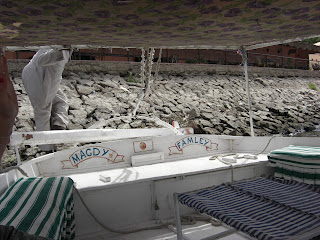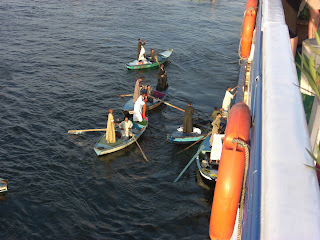
After leaving Kom Ombo, we sailed overnight to Aswan, the last point on our tour. That final night, our boat had a big Galabeya party. Most of the guests had purchased inexpensive costumes during the cruise for the big party. Within our little group, Stu was the only participant however. He looked very regal in his $6 Galabeya. Who wouldn't want to be part of his harem?
When we awoke the next morning, we were in Aswan. Before meeting up with Ahmed, our tour guide, we got packed up and checked out of our cabins. The first stop on our day of sightseeing was the Aswan Dam.
There are actually two dams here. The low dam, which was built in 1902 and the high dam which was built in 1970. Prior to the dams, the Nile would flood every year. In ancient times, it was an important part of the planting season, as the flood would bring sediments and nutrients that would make the soil ideal for planting. However, as the populations grew and the agricultural industry got more complex, the floods began to have detrimental effects, posing great risks to human life or to high priced cotton fields.
The high dam was actually built around an era of international tension. The original low dam was proving inadequate. The leader at the time, Gamal Abdel Nasser, had just taken control of Egypt in a 1954 revolution. He was trying to portray himself as an Arab nationalist, not just Egyptian. He was dealing with lots of conflict from Iraq and Jordan at this time as well. The US saw him as an ally to prevent communism from entering the Middle East and agreed to help fund the damn in exchange for Nasser helping resolve Arab-Israeli conflict. Nasser didn't like being pushed around by Israel and so when he asked for weapons help from the US, he was granted his request, but only if the US could supervise the training, which he did not like. Nasser threatened to go to the Soviet Union for help instead. The US thought this was a bluff, so they withdrew their offer to fund the dam and supply weapons. Thinking that Egypt would come back under new terms, they were rather shocked when the Soviet Union offered to fund the dam's construction.

The dam is 3830 meters long, 980 meters wide. 11,000 cubic meters of water pass thru the dam every second.
The dam is hydro electric, so it generates about half of Egypt's electricity production. Most smaller villages in the country received electricity for the first time as a result of the dam. The dam has 12 generators with an output of 2.1 gigawatts of electricity.
Lake Nasser is 550km long and 35km at it's widest. From the dam it extends all the way back to the Sudan border. The artificial lake started filling in 1964 and reached capacity in 1976. As a result, some 60,000 people were displaced and countless antiquities sites had to be rescued and removed before they were lost to the rising water.


The dam has been both good and bad for Egypt. It has controlled very devastating floods that used to kill scores of people and ruin whole seasons of crops. Because the water can be controlled, there is no longer a problem with drought seasons either. However, land erosion due to lack of new sediments is a growing problem, as is the use of chemical fertilizers. Prior to the dams, the flooding would deposit rich sediment into the soil. Now that this doesn't happen, the use of chemical fertilizers has been introduced to support agriculture. These chemicals now flow down the Nile and empty into the Mediterranean Sea. The dam is also causing the salinity of the Mediterranean to rise as the water logged soils at Lake Nasser are causing salt to rise to the surface. Scientists have now traced that salt as far as the Atlantic Ocean, where the Mediterranean empties at Gibraltar.
 For the month of November, I bumped back to domestic flying. I did so with the intention of getting a great line with a long Tampa layover on the 26th or even getting a line that had the whole day of the 26th off. HOWEVER, in the rush to put my bids in, I selected line 164, when I really wanted line 165. Well, bid awards come out and I get my first choice, 164, which was a line I did not even want.
For the month of November, I bumped back to domestic flying. I did so with the intention of getting a great line with a long Tampa layover on the 26th or even getting a line that had the whole day of the 26th off. HOWEVER, in the rush to put my bids in, I selected line 164, when I really wanted line 165. Well, bid awards come out and I get my first choice, 164, which was a line I did not even want.

























































